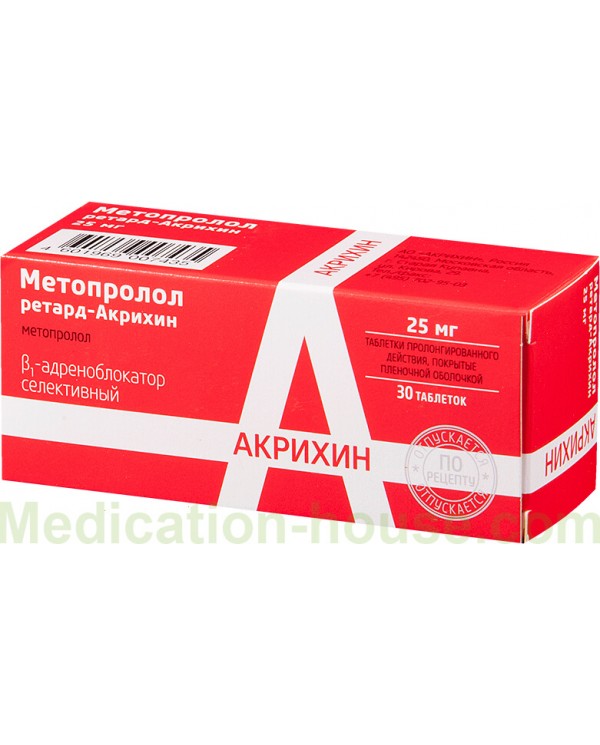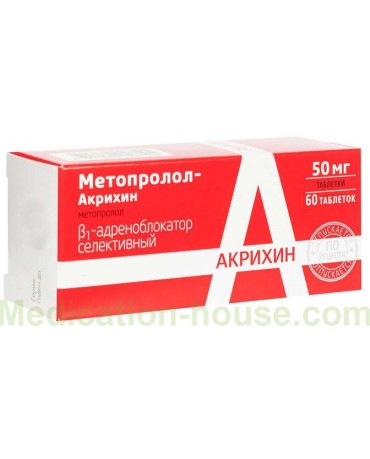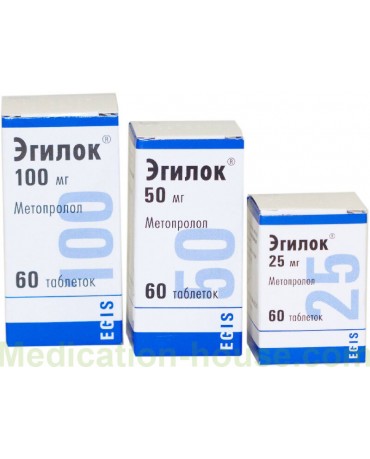Metoprolol Retard user manual
You can buy Metoprolol Retard on this page
Pharmachologic effect
Cardioselective beta1-blocker. It does not have a membrane stabilizing effect and does not have internal sympathomimetic activity. It has antihypertensive, antianginal and antiarrhythmic effects.
Blocking in low doses β1-adrenergic receptors of the heart, reduces the formation of cAMP from ATP stimulated by catecholamines, reduces the intracellular flow of calcium ions, has a negative chrono-, dromo-, batmo- and inotropic effect (reduces heart rate, inhibits conductivity and excitability, reduces myocardial contractility). OPSS at the beginning of the use of beta-blockers (in the first 24 hours after oral administration) increases (as a result of a reciprocal increase in the activity of α-adrenergic receptors and elimination of stimulation of β2-adrenergic receptors), after 1-3 days it returns to the original, and decreases with prolonged administration.
The antihypertensive effect is due to a decrease in the minute volume of blood flow and renin synthesis, inhibition of the RAAS activity (it is more important in patients with initial hypersecretion of renin) and the central nervous system, restoration of the sensitivity of the aortic arch baroreceptors (there is no increase in their activity in response to a decrease in blood pressure) and, as a result, a decrease in peripheral sympathetic influences. Reduces high blood pressure at rest, during physical exertion and stress. The antihypertensive effect lasts more than 24 hours.
The antianginal effect is determined by a decrease in myocardial oxygen demand as a result of a decrease in heart rate (lengthening of diastole and an improvement in myocardial perfusion) and contractility, as well as a decrease in myocardial sensitivity to the effects of sympathetic innervation. Reduces the number and severity of angina attacks and increases exercise tolerance. By increasing the end-diastolic pressure in the left ventricle and increasing the stretching of the muscle fibers of the ventricles, oxygen demand can increase, especially in patients with chronic heart failure.
The antiarrhythmic effect is due to the elimination of arrhythmogenic factors (tachycardia, increased activity of the sympathetic nervous system, increased cAMP content, arterial hypertension), a decrease in the rate of spontaneous excitation of sinus and ectopic pacemakers and a slowdown in AV conduction (mainly in the antegrade and to a lesser extent in the retrograde directions through the AV -node) and along additional paths.
With supraventricular tachycardia, atrial fibrillation, sinus tachycardia in functional heart diseases and thyrotoxicosis, it slows down the heart rate or may even lead to the restoration of sinus rhythm.
Prevents the development of migraines.
In contrast to non-selective beta-blockers, when administered in medium therapeutic doses, it has a less pronounced effect on organs containing β2-adrenergic receptors (pancreas, skeletal muscles, smooth muscles of peripheral arteries, bronchi and uterus) and on carbohydrate metabolism; the severity of atherogenic action does not differ from the action of propranolol. When taken for many years, it reduces the concentration of cholesterol in the blood. When used in large doses (more than 100 mg / day), it has a blocking effect on both subtypes of β-adrenergic receptors.
Indications
arterial hypertension;
chronic heart failure II-IV functional class according to NYHA classification in the stage of compensation (as part of complex therapy);
IHD: prevention of attacks of stable angina pectoris, reduction of mortality and the frequency of repeated myocardial infarction after the acute phase of myocardial infarction;
cardiac arrhythmias, including supraventricular tachycardia, a decrease in the rate of ventricular contraction in atrial fibrillation and ventricular extrasystoles;
functional disorders of cardiac activity, accompanied by tachycardia;
prevention of migraine attacks.
Method of application, course and dosage
The drug Metoprolol retard is taken orally 1 time / day. It is recommended to take the tablets in the morning, without chewing, with water. Metoprolol retard can be taken with or without food.
In order to prevent bradycardia, the dose is selected individually and increased gradually.
With arterial hypertension and angina pectoris, the initial dose is 50 mg 1 time / day, with insufficient therapeutic effect, the daily dose can be increased to 100-200 mg / day. With arterial hypertension, if the drug is ineffective at a dose of 100-200 mg / day, another antihypertensive agent can be added.
In chronic heart failure of functional class II according to the NYHA classification (without exacerbations for the last 6 weeks and without changes in complex therapy during the last 2 weeks), the recommended initial dose is 25 mg 1 time / day. After 2 weeks, the daily dose can be increased to 50 mg, then after 2 weeks - up to 100 mg, after another 2 weeks - up to 200 mg.
In chronic heart failure of the III-IV functional class according to the NYHA classification, the recommended initial dose is the first 2 weeks 12.5 mg 1 time / day. It is possible to use metoprolol in another dosage form, for example, 25 mg scored tablets. During the period of increasing the dose, the patient should be monitored, because in some patients, symptoms of heart failure may worsen.
After 1-2 weeks, the dose can be increased to 25 mg 1 time / day. Then, after 2 weeks, the dose can be increased to 50 mg 1 time / day. In patients who tolerate the drug well, the dose can be doubled every 2 weeks until a maximum dose of 200 mg is reached 1 time / day.
In the secondary prevention of myocardial infarction and cardiac arrhythmias, the initial dose is 100 mg 1 time / day.
With functional disorders of cardiac activity, accompanied by tachycardia, appoint 50 mg / day, if necessary, the dose can be increased to 200 mg / day.
For the prevention of migraine attacks, 100-200 mg are prescribed 1 time / day.
Elderly patients, patients with renal insufficiency or patients on hemodialysis do not need dose adjustment.
Liver dysfunction affects the elimination of metoprolol, therefore, dose adjustment may be required depending on the clinical condition.
Overdose
Symptoms: severe bradycardia, AV block (up to the development of complete transverse blockade and cardiac arrest), excessive decrease in blood pressure, impaired peripheral circulation, increased symptoms of heart failure, cardiogenic shock, respiratory depression, apnea, cyanosis, fatigue, dizziness, loss of consciousness , coma, tremor, convulsions, excessive sweating, paresthesia, bronchospasm, nausea, vomiting, possible development of esophagospasm, hypoglycemia or hyperglycemia, hyperkalemia, transient myasthenia gravis. The first signs of an overdose appear 20 minutes to 2 hours after taking the drug.
Treatment: if the drug has been recently taken - gastric lavage and intake of adsorbing agents; in case of violation of AV conduction and / or bradycardia - intravenous administration of 1-2 mg of atropine, epinephrine (adrenaline) or setting of a temporary pacemaker; with a decrease in blood pressure, the patient should be transferred to the Trendelenburg position. If there are no signs of pulmonary edema - IV plasma-substituting solutions, if ineffective - the introduction of epinephrine, dopamine, dobutamine; in acute heart failure - cardiac glycosides, diuretics; with convulsions - intravenous diazepam; with bronchospasm - inhalation or parenteral beta2-adrenergic agonists.
Drug interactions
Drugs that reduce the supply of catecholamines (for example, reserpine, MAO inhibitors), when used simultaneously with metoprolol, can increase the hypotensive effect or cause severe bradycardia. The break in treatment between taking MAO inhibitors and metoprolol should be at least 14 days.
Metoprolol is a substrate of the CYP2D6 isoenzyme. Medicines that inhibit or induce CYP2D6 activity can affect the plasma concentration of metoprolol.
Inhibitors of CYP2D6 (some antidepressants and neuroleptics, quinidine, terbinafine, celecoxib, propafenone, diphenhydramine, hydroxychlorine, cimetidine) increase the plasma concentration of metoprolol.
CYP2D6 inducers (derivatives of barbituric acid, rifampicin) reduce the concentration of metoprolol in blood plasma.
Simultaneous administration of metoprolol with cardiac glycosides, clonidine, slow calcium channel blockers (verapamil, diltiazem), amiodarone, class I antiarrhythmics, general anesthetics, methyldopa, guanfacine can lead to a decrease in blood pressure and severe bradycardia.
Means for inhalation anesthesia (derivatives of hydrocarbons), when used simultaneously with metoprolol, increase the risk of myocardial function suppression and the development of arterial hypotension.
Simultaneous intravenous administration of verapamil can provoke cardiac arrest.
NSAIDs and beta-adrenergic agonists weaken the antihypertensive effect of beta-blockers.
Ergot alkaloids, when used simultaneously with metoprolol, increase the risk of peripheral circulatory disorders.
When metoprolol is taken together with oral hypoglycemic drugs, their effect may be reduced; with insulin - increasing the risk of hypoglycemia, lengthening and increasing its severity, masking some symptoms of hypoglycemia (tachycardia, sweating, increased blood pressure).
Metoprolol reduces the clearance of xanthines (except for diaphylline), especially in patients with an initially increased clearance of theophylline under the influence of smoking.
Metoprolol reduces the clearance of lidocaine, increases the concentration of lidocaine in plasma.
Metoprolol enhances and prolongs the effect of non-depolarizing muscle relaxants; lengthens the anticoagulant effect of coumarins.
With the simultaneous administration of epinephrine (adrenaline) with beta-blockers, an increase in blood pressure and bradycardia is possible.
Phenylpropanolamine (norephedrine), when used simultaneously with metoprolol, can increase diastolic blood pressure.
Allergens used for immunotherapy or allergen extracts for skin tests when combined with metoprolol increase the risk of systemic allergic reactions or anaphylaxis.
Iodine-containing X-ray contrast agents for intravenous administration, when used together with metoprolol, increase the risk of developing anaphylactic reactions.
With the combined use of metoprolol with ethanol, the risk of a pronounced decrease in blood pressure increases.
Application during pregnancy and lactation
During pregnancy, the drug Metoprolol retard should be used only under strict indications, when the expected benefit to the mother outweighs the potential risk to the fetus / child (due to the possible development of bradycardia in the newborn, lowering blood pressure, hypoglycemia and respiratory paralysis). At the same time, careful monitoring is carried out, especially for the development of the fetus. Treatment is stopped 48-72 hours before the onset of labor. If this is not possible, the newborn should be closely monitored for 48-72 hours after delivery.
The use of the drug Metoprolol retard is contraindicated during lactation. If it is necessary to use the drug during lactation, breastfeeding should be discontinued.
Side effect
Frequency of side effects: very often (> 1/10), often (> 1/100 and <1/10), infrequently (> 1/1000 and <1/100), rarely (> 1/10 000 and <1 / 1000), very rare (<1/10 000, including individual messages).
From the side of the cardiovascular system: often - bradycardia, orthostatic hypotension (including fainting), coldness of the lower extremities, palpitations; infrequently - a temporary increase in the symptoms of heart failure, cardiogenic shock in patients with myocardial infarction, AV block of the 1st degree; rarely - myocardial conduction disorders, arrhythmia; very rarely - gangrene (in patients with peripheral circulatory disorders).
From the side of the central nervous system: very often - increased fatigue, decreased speed of mental and motor reactions; often - dizziness, headache; infrequently - paresthesia, convulsions, depression, decreased concentration, drowsiness, insomnia, nightmares; rarely - asthenia, tremor, increased nervous irritability, anxiety; very rarely - amnesia / memory impairment, depression, hallucinations, myasthenia gravis.
From the senses: rarely - visual impairment, dryness and / or irritation of the eyes, conjunctivitis; very rarely - ringing in the ears, impaired taste.
From the digestive system: often - nausea, abdominal pain, constipation or diarrhea; infrequently - vomiting; rarely - dryness of the oral mucosa, abnormal liver function, hepatitis.
On the part of the skin: infrequently - urticaria, increased sweating; rarely - alopecia; very rarely - photosensitivity, exacerbation of the course of psoriasis, psoriasis-like skin reactions.
From the respiratory system: often - shortness of breath; infrequently - bronchospasm in patients with bronchial asthma; rarely - rhinitis.
On the part of laboratory parameters: very rarely - thrombocytopenia (unusual bleeding and hemorrhage), agranulocytosis, leukopenia, increased activity of liver enzymes, hyperbilirubinemia.
From the endocrine system: often - hypoglycemia (in patients with type 1 diabetes mellitus), rarely - hyperglycemia (in patients with type 2 diabetes mellitus), hypothyroidism.
Others: infrequently - an increase in body weight; rarely, impotence / sexual dysfunction; very rarely - arthralgia, thrombocytopenia.
Contraindications for use
cardiogenic shock;
AV block II-III degree;
sinoatrial blockade;
SSSU;
severe bradycardia (heart rate <50 beats / min);
acute heart failure or chronic heart failure in the stage of decompensation;
arterial hypotension (systolic blood pressure <100 mm Hg);
acute myocardial infarction (heart rate <45 beats / min, PQ interval more than 0.24 s, systolic blood pressure <100 mm Hg);
severe bronchial asthma;
severe peripheral circulatory disorders;
simultaneous administration of MAO inhibitors or simultaneous intravenous administration of verapamil;
pheochromocytoma (without the simultaneous administration of alpha-blockers);
age up to 18 years (efficacy and safety have not been established);
lactation period;
lactase deficiency, lactose intolerance, glucose / galactose malabsorption syndrome;
hypersensitivity to metoprolol and other beta-blockers.
With caution, the drug should be prescribed for diabetes mellitus, AV blockade of I degree, Prinzmetal angina pectoris, metabolic acidosis, bronchial asthma, COPD, renal and / or hepatic failure of severe degree, myasthenia gravis, pheochromocytoma (while taking alpha-blockers), thyrotoxicosis (including history), psoriasis, peripheral circulatory disorders (intermittent claudication, Raynaud's syndrome), pregnancy, as well as elderly patients.
Special instructions
Monitoring patients taking beta-blockers includes regular monitoring of heart rate and blood pressure. The patient should be trained in the method of calculating the heart rate and instructed on the need for medical advice if the heart rate is less than 50 beats / min.
An increase in the severity of allergic reactions (against the background of a burdened allergic history) and the lack of effect from the introduction of conventional doses of epinephrine (adrenaline) is possible.
In elderly patients, it is recommended to monitor kidney function (once every 4-5 months).
Taking the drug Metoprolol retard may increase the symptoms of impaired peripheral arterial circulation.
With angina pectoris, the selected dose of the drug should provide a resting heart rate within 55-60 beats / min, with a load - no more than 110 beats / min.
In smoking patients, the effectiveness of beta-blockers is lower.
Metoprolol retard can mask some clinical manifestations of thyrotoxicosis (for example, tachycardia). Abrupt withdrawal of the drug in patients with thyrotoxicosis is contraindicated, since it can increase the symptoms.
With diabetes mellitus, taking the drug Metoprolol retard can mask tachycardia caused by hypoglycemia.
If necessary, prescribing to patients with bronchial asthma, beta2-adrenomimetics are used as concomitant therapy; with pheochromocytoma - alpha-blockers.
If it is necessary to carry out a surgical intervention, it is necessary to warn the anesthesiologist about taking the drug Metoprolol retard (it is necessary to choose a means for general anesthesia with a minimal negative inotropic effect), the withdrawal of the drug is not recommended.
Reciprocal activation of the vagus nerve can be eliminated by intravenous administration of atropine (1-2 mg).
In the event of increasing bradycardia (less than 50 beats / min), arterial hypotension (systolic blood pressure below 100 mm Hg), AV blockade, bronchospasm, ventricular arrhythmias, severe liver and kidney dysfunction, it is necessary to reduce the dose or stop treatment.
It is recommended to discontinue therapy with the appearance of skin rashes and the development of depression caused by the intake of beta-blockers.
With a sharp withdrawal of clonidine, blood pressure can sharply increase, while taking beta-blockers. In case of cancellation of clonidine, the discontinuation of beta-blockers should be started several days before the cancellation of clonidine.
Drugs that reduce the supply of catecholamines (for example, reserpine) can increase the effect of beta-blockers, therefore, patients taking such combinations of drugs should be under constant medical supervision for an excessive decrease in blood pressure or bradycardia.
With an abrupt termination of treatment, a withdrawal syndrome may occur (increased angina attacks, increased blood pressure). When discontinuing the drug, special attention should be paid to patients with angina pectoris, chronic heart failure, after myocardial infarction. Cancellation of the drug Metoprolol retard is carried out gradually, reducing the dose within 10 days.
Patients using contact lenses should take into account that during treatment with beta-blockers, it is possible to reduce the production of tear fluid.
Influence on the ability to drive vehicles and mechanisms
During the period of treatment, care must be taken when driving vehicles and engaging in other potentially hazardous activities that require increased concentration of attention and speed of psychomotor reactions.
Application for impaired renal function
No dose adjustment is required in patients with renal insufficiency or in patients on hemodialysis.
Application for violations of liver function
Liver dysfunction affects the elimination of metoprolol, therefore, dose adjustment may be required depending on the clinical condition.
Use in elderly patients
Elderly patients do not need dose adjustment.
In elderly patients, it is recommended to monitor kidney function (once every 4-5 months).
Application in children
Contraindicated in children and adolescents under 18 years of age.
Terms of sell
A prescription is not required to buy Metoprolol Retard.



